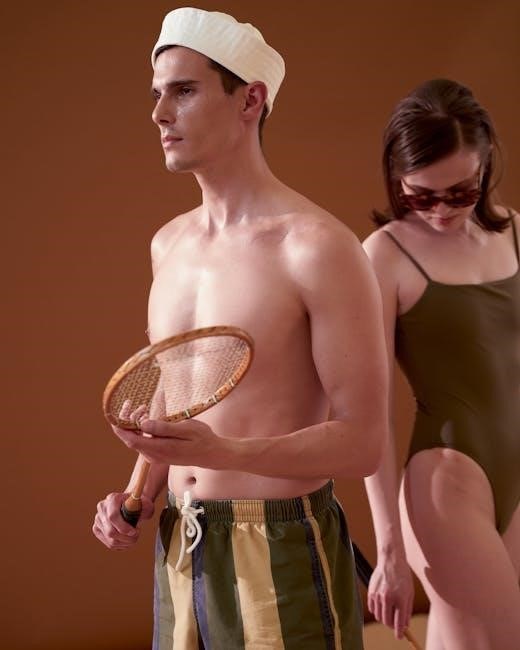Welcome to our comprehensive guide on selecting the perfect tennis racket! Choosing the right racket can elevate your game, ensuring optimal performance and comfort. Whether you’re a beginner or an advanced player, understanding key factors like size, weight, string pattern, and material is crucial. This guide will walk you through everything you need to know to make an informed decision and find your ideal match on the court.
Key Factors to Consider When Buying a Tennis Racket
When selecting a tennis racket, consider size, weight, string pattern, and material. Lighter rackets offer maneuverability, while stiffer frames provide power. Multi-filament strings enhance comfort and durability, making them ideal for various playing styles. Ensure the racket aligns with your skill level and personal preferences for optimal performance.
Understanding Racket Size and Weight
Racket size and weight significantly impact performance. Lighter rackets (245-270g) suit beginners or juniors, offering easier maneuverability. Heavier rackets (280-320g) provide stability and power, ideal for advanced players. Racket length also matters, with standard 27-29 inches suitable for most adults, while shorter rackets (23-26 inches) are designed for juniors. Balance plays a role too—head-heavy rackets generate more power, while handle-heavy rackets enhance control. Consider your strength and style when choosing, as the right size and weight ensure comfort and effectiveness during play. Customization options like adding weight can further personalize your racket.
Importance of String Pattern and Tension
The string pattern and tension dramatically influence a racket’s performance. A denser pattern (e.g., 18×20) offers more control and spin potential, while an open pattern (e.g., 16×19) maximizes power and spin. String tension ranges from 40 to 65 lbs; lower tensions generate more power and comfort, while higher tensions provide better control and durability. Finding the right balance is key to optimizing your game. Players with slower swings may prefer lower tension for added pop, while those with faster swings benefit from higher tension for precision. Proper stringing ensures consistent play and minimizes arm strain, making it a critical factor in racket customization.
Material Types and Their Impact on Performance
Tennis rackets are made from various materials, each offering unique benefits. Graphite rackets are lightweight and ideal for generating power, making them popular among professionals. Aluminum rackets are durable and cost-effective, often recommended for beginners. Titanium rackets combine strength and lightness, offering a balance between power and control. Fiberglass rackets are flexible, reducing vibration and suit players with arm issues. Advanced materials like basalt and kevlar enhance performance by providing superior energy return and stability. The choice of material significantly affects the racket’s weight, power, and feel, ensuring there’s an option for every player’s style and preference.
Racket Balance and Its Effect on Play
Racket balance plays a crucial role in performance, directly influencing how the racket feels during play. A head-heavy racket provides more power and momentum, ideal for aggressive players who rely on strong groundstrokes. Conversely, a head-light racket offers better maneuverability and control, benefiting those who focus on precision and quick reflexes. An even balance strikes a middle ground, catering to all-around players. The balance point affects swing speed, stability, and comfort, making it essential to choose a racket that aligns with your playing style and strengths. Proper balance enhances overall performance and reduces fatigue during matches.
How to Choose the Right Grip Size
Choosing the right grip size is essential for comfort, control, and performance. Measure your hand size by placing a ruler perpendicular to the palm at the base of the fingers. Grip sizes typically range from 4 to 4 7/8 inches. A proper fit allows the index finger of your non-dominant hand to fit snugly between the tips of the fingers and the heel of the hand when the racket is held. If the grip is too small, it may cause discomfort or injury. If too large, it can hinder control. Most players prefer a grip size that feels natural and allows precise handling of the racket.
Role of Technology in Modern Rackets
Modern tennis rackets incorporate cutting-edge technology to enhance performance. Advanced materials like graphite and nanomaterials create lightweight yet durable frames. Smart rackets now feature sensors to track metrics like swing speed and ball impact. Vibration dampening systems reduce shock, improving comfort and playability. Aerodynamic designs minimize drag, allowing faster swings. These innovations cater to various playing styles, offering precision, power, and control. Players can benefit from tailored technologies that suit their game, making modern rackets more adaptable and efficient than ever before.

Choosing the Right Racket Based on Skill Level
Choosing the right tennis racket based on skill level is crucial for optimal performance. Beginners benefit from forgiving designs, intermediate players need balanced performance, and advanced players seek precision. Selecting a racket that matches your skill level enhances gameplay and confidence.

Best Rackets for Beginners
Beginners should opt for rackets with larger head sizes (105-135 sq. in.) and lighter weights (240-270g) for easier maneuverability. Open string patterns (16×19 or 18×20) reduce vibration and offer forgiveness. Rackets made from aluminum or graphite-aluminum blends are durable and cost-effective. Look for models with longer handles for better leverage. Brands like Wilson, Babolat, and Head offer excellent entry-level options. These rackets prioritize comfort, power, and control, helping new players build confidence and improve technique without overwhelming them with advanced features.
Intermediate Players: What to Look For
Intermediate players should seek rackets offering a balance of power and control. A mid-range head size (98-105 sq. in.) and medium weight (280-300g) are ideal. Look for a moderate string pattern (16×19 or 18×20) for consistent play. Graphite or graphite-blend frames provide durability and responsiveness. A slightly head-light balance enhances maneuverability. Features like dampening systems or precision grommets improve comfort and accuracy. Brands like Wilson, Babolat, and Head offer models tailored for intermediates, blending versatility with performance to support improving skills and all-court playstyles.
Advanced Players: High-Performance Rackets
Advanced players require rackets that deliver precision, control, and consistency. Look for smaller head sizes (95-100 sq. in.) and heavier weights (310g+) for added stability and plow-through; A dense string pattern (18×20 or 20×22) enhances spin control and accuracy. High-end materials like premium graphite ensure exceptional stiffness and responsiveness. A head-light or even balance improves maneuverability for advanced techniques. Features like thin beams or unique grommet systems optimize performance. Top brands offer pro-level models designed for tournament play, catering to skilled players seeking exacting precision and power.

Types of Tennis Rackets
Tennis rackets vary by type, including power, control, and all-around models, each catering to different playing styles and player preferences.
Power and Game Improvement Rackets
Power and game improvement rackets are designed for players seeking increased power and forgiveness. These rackets typically feature larger head sizes, wider beam widths, and open string patterns to maximize ball pop and reduce vibration. They are ideal for intermediate players or those with slower swing speeds, offering easier power generation. Lightweight designs enhance maneuverability, while larger sweet spots provide consistency. These rackets are excellent for bridging the gap between power and control, making them a popular choice for improving technique and confidence on the court.
Tournament and Control-Oriented Rackets
Tournament and control-oriented rackets are designed for advanced players who prioritize precision and consistency. These rackets typically feature smaller to medium head sizes, tighter string patterns, and balanced or head-light designs for enhanced maneuverability. They offer exceptional feel and responsiveness, allowing for precise shot placement and spin control. Often made from high-quality materials like graphite, these rackets deliver a more traditional playing experience. While they may lack the raw power of game improvement rackets, they excel in delivering pinpoint accuracy and consistency for skilled players seeking ultimate control over their game.
Specialized Rackets for Specific Styles
Specialized rackets cater to unique playing styles, offering tailored performance for specific techniques. For serve-and-volley players, rackets with enhanced power and precision are ideal, while baseline players benefit from rackets with added control and durability. Spin-oriented players often choose rackets with open string patterns and textured surfaces to maximize rotation. Some rackets are designed for doubles specialists, emphasizing quick handling and maneuverability. Brands like Wilson and Dunlop offer models tailored to these styles, ensuring players can optimize their performance based on their strengths and preferences. Matching the racket to your style enhances execution and overall game effectiveness.
Customizing Your Tennis Racket
Customizing your racket enhances performance and comfort. Players can adjust string tension, grip size, and balance to suit their style, optimizing power, control, and feel.
Stringing Options for Different Play Styles
Stringing options significantly impact performance. Polyester strings offer durability and spin potential, ideal for aggressive players. Natural gut provides exceptional feel and power, suited for precise hitters. Nylon strings balance durability and playability, making them versatile for various styles.
String tension also plays a role: higher tension increases control but can reduce power, while lower tension boosts power but may sacrifice accuracy. Players can choose between dense or open string patterns to optimize spin, control, or power based on their game style.
Adjusting Racket Balance for Optimal Play
Racket balance is crucial for performance, as it affects swing weight and maneuverability. A head-heavy racket provides more power, ideal for strong hitters, while a handle-heavy design enhances control and precision. Players can customize balance by adding lead tape to the head or handle. This adjustment allows tailoring the racket to individual swing styles, ensuring optimal energy transfer and comfort during play; Proper balance can elevate performance, making it a key customization aspect for serious players seeking to refine their game.
Custom Grips and Overgrips for Comfort
Custom grips and overgrips play a vital role in enhancing comfort and performance. They provide a secure hold, reducing hand fatigue and preventing slipping during intense play; Overgrips can be tailored to personal preferences, offering varying levels of tackiness and cushioning. Players with sweaty hands benefit from tacky overgrips, while those seeking shock absorption prefer cushioned options; Custom grips also allow for personalization, ensuring a perfect fit and feel. This customization enhances overall control, making it easier to maintain consistency and power during matches.
Where to Buy Your Tennis Racket
Research and compare options at online retailers, specialty stores, and second-hand marketplaces to find the best fit for your needs and budget.
Online Retailers: Pros and Cons
Online retailers offer convenience, wide selection, and competitive pricing. They often provide detailed product descriptions, customer reviews, and price-matching options. However, you can’t test the racket before buying, and return policies may be inconvenient. Shipping costs and delivery times can add to the overall expense. Despite these drawbacks, online stores remain a popular choice for their accessibility and variety. Always check for authenticity and warranties when purchasing from online platforms to ensure a satisfactory experience.
Visiting a Specialty Tennis Store
Visiting a specialty tennis store offers personalized service and hands-on experience. Expert staff can guide you through racket selection, ensuring the best fit for your skill level and style. You can demo rackets to feel their weight, balance, and swing. This direct interaction helps you make an informed decision. Additionally, specialty stores often offer on-site stringing and grip adjustments, ensuring your racket is tailored to your preferences. The ability to test equipment and receive professional advice makes specialty stores a valuable resource for serious players seeking the perfect racket.
Considerations for Buying Second-Hand Rackets
When buying a second-hand racket, inspect for wear, such as cracks or frame damage. Check the string condition, as worn or frayed strings may need replacing. Ensure the grip is clean and intact, as a worn grip can affect play. Ask about the racket’s history, including usage frequency and restringing. Test the balance and weight to ensure it suits your style. Compare prices to ensure fairness, avoiding overly cheap options that may indicate poor condition. A trial hit can reveal performance quirks. Finally, verify if the racket still has a warranty, though most second-hand rackets do not.
Maintenance and Care of Your Racket
Regularly clean your racket to prevent dirt buildup. Protect strings from damage and store in a dry place. Avoid extreme temperatures and use a racket cover.
Regular String Maintenance
Regular string maintenance is crucial for optimal racket performance. Strings lose tension over time, affecting power and control. Most players restring their rackets every 1-3 months, depending on usage. Heavy hitters or those with aggressive swings may need more frequent restringing. Check strings for frays or breaks, as damaged strings can lead to uneven performance. Maintaining proper tension ensures consistent play and prevents premature string wear. Clean strings with a damp cloth to remove dirt and grime, and avoid exposure to harsh chemicals. Proper care extends string life and maintains racket efficiency.
Cleaning and Protecting Your Racket
Cleaning and protecting your racket ensures longevity and maintains performance. Use a soft, dry cloth to wipe away dirt and sweat from the frame and strings. For tougher grime, dampen the cloth with water, but avoid harsh chemicals. Protect the racket by storing it in a cover when not in use to prevent scratches. Apply a UV-protective cover to shield from sun damage. Regular cleaning prevents dust buildup and keeps the racket looking new. Proper care extends the life of your racket and preserves its performance.
Storage Tips to Prolong Racket Life
To prolong your racket’s life, store it in a cool, dry place away from direct sunlight. Avoid extreme temperatures, such as car trunks or attics. Use a racket cover to protect it from dust and scratches. Do not lean the racket against walls or surfaces where it could bend or warp. Store it upright or flat in a protective case to maintain frame integrity. Proper storage prevents damage and ensures your racket remains in optimal condition for future use. Consistent care will extend its lifespan and performance.

Essential Accessories for Your Racket
Essential accessories enhance racket performance and player comfort. Tennis bags protect rackets during transport. Dampeners reduce string noise for focus. Overgrips and replacement handles provide grip comfort.
Choosing the Right Tennis Bag
Selecting the right tennis bag ensures protection for your gear and convenience during matches. Consider capacity, durability, and comfort. Capacity should fit multiple rackets, extra clothes, and shoes. Durable materials like nylon or polyester withstand heavy use. Look for padded straps for comfort and multiple compartments for organization. Additional pockets for small items like balls or keys add functionality. Style and color allow personal expression. Check for weather-resistant linings to protect gear from moisture. A well-chosen bag enhances your tennis experience and keeps essentials organized.
Importance of Dampeners and Vibration Reduction

Dampeners and vibration reduction are crucial for enhancing comfort and performance. They minimize the sting and discomfort caused by ball impact, especially on off-center hits. Vibration dampeners absorb shock, reducing strain on the arm and shoulder. This helps prevent injuries like tennis elbow. Modern rackets often feature built-in vibration dampening systems, while external dampeners can be added to strings. Reducing vibration improves feel and control, allowing players to focus on precise shots. Prioritizing vibration reduction ensures a smoother, more enjoyable playing experience for all skill levels.
Overgrips and Replacement Handles
Overgrips and replacement handles are essential for personalizing your racket’s feel and comfort. Overgrips add cushioning, absorb sweat, and improve traction, enhancing control during play. They come in various thicknesses and textures, allowing customization based on preference. Replacement handles offer a fresh grip, ideal for renewing an old racket or tailoring the grip size. Both options ensure a secure hold, reducing fatigue and preventing blisters. Choosing the right overgrip or handle can elevate your game by providing comfort and confidence, making them valuable additions to your racket setup.

Key Brands and Their Reputation
Top brands like Wilson, Babolat, and Head dominate the market, offering high-quality rackets trusted by pros and amateurs alike for their innovation, durability, and performance.
Wilson: A Legacy in Tennis
Wilson is a titan in the tennis world, renowned for its rich history and commitment to innovation. Founded in 1913, the brand has been a cornerstone of the sport, producing iconic rackets like the T2000, which revolutionized the game with its steel construction. Trusted by legends such as Billie Jean King and Serena Williams, Wilson rackets are celebrated for their blend of power, control, and precision. The brand continues to evolve, merging classic designs with cutting-edge technology to meet the demands of modern players. Wilson’s dedication to excellence ensures it remains a favorite among tennis enthusiasts worldwide.
Babolat: Innovation and Quality
Babolat is a French brand with a rich history dating back to 1875, known for its high-quality tennis rackets. The company pioneered the first tennis racket with natural gut strings and continues to innovate with advanced materials like graphite. Its iconic models, such as the Pure Drive and AeroPro, are favored by pros like Rafael Nadal. Babolat’s focus on precision, power, and comfort has solidified its reputation as a leader in tennis equipment. Their rackets blend tradition with cutting-edge technology, offering exceptional performance for players of all levels.
Head: Precision and Performance
Head is an Austrian-based company renowned for its high-quality sports equipment, particularly in tennis. Known for their innovative designs, Head rackets are favored by top players like Novak Djokovic and Andy Murray. Their Graphene technology reduces weight while enhancing power and stability. The Speed and Radical series are popular choices, offering a balance of power and control. Head’s commitment to precision and performance makes their rackets a top choice for players seeking a blend of innovation and reliability.
Dunlop and Yonex: Reliable Options
Dunlop and Yonex are trusted brands offering reliable tennis rackets for players of all levels. Dunlop, with its rich history, is known for durable and versatile rackets like the Srixon Revo series, which combines power and control. Yonex, a Japanese brand, is celebrated for its innovative technology, such as the Isometric head shape for larger sweet spots. Their EZONE and Astrel series are popular for precision and comfort. Both brands cater to varying play styles, making them excellent choices for players seeking consistency and performance.
Emerging Brands and Their Offerings
Emerging brands like Solinco and Angell are making waves in the tennis racket market with innovative designs and performance-driven features. Solinco focuses on high-performance rackets with advanced string patterns, appealing to competitive players. Angell, known for its customizable options, offers rackets tailored to individual preferences. These brands emphasize quality and uniqueness, providing players with fresh alternatives to traditional choices. Their commitment to innovation and player-centric designs makes them worth considering for those seeking distinct play experiences and cutting-edge technology in their rackets.

Final Tips for Buying the Right Racket
Test rackets before purchasing, prioritize personal feel over brand reputation, and consider future growth. Avoid common mistakes like ignoring grip size and string pattern preferences.

Trying Before Buying: Demo Options
Testing a racket before purchasing is crucial to ensure it suits your style. Many specialty stores and online retailers offer demo programs, allowing you to trial rackets for a small fee. Take advantage of these options to assess how the racket performs during actual play. Spend a few sessions with each demo model to understand its feel, power, and control. Comparing multiple rackets side by side can help you identify the best fit. Pay attention to comfort, maneuverability, and how it enhances your game. This hands-on approach ensures you make an informed decision.
Avoiding Common Mistakes
When buying a tennis racket, avoid common pitfalls to ensure the right choice. Many players prioritize brand reputation over personal needs, leading to poor performance. Others overlook their skill level, selecting rackets too advanced or too basic. Neglecting grip size is another mistake, as improper fit can hinder comfort and control. Additionally, some buyers skip considering string tension, which impacts power and precision. Lastly, ignoring racket balance can result in a mismatch with playing style. Focus on your specific needs, and don’t rush the decision to find the best fit for your game.

Considering Future Growth and Development
When selecting a tennis racket, it’s essential to think about your future growth as a player. Choose a racket that allows for adjustments as your skills improve, such as customizable string tension or removable weights. Avoid rackets that are too advanced or restrictive, as they may hinder development. Opt for a versatile option that can adapt to your evolving style. Investing in a racket with room for growth ensures you won’t need frequent upgrades, saving money and hassle. This approach supports your long-term progress and enjoyment of the game.
Selecting the right tennis racket is a personal decision, balancing performance, comfort, and style. By understanding your needs and preferences, you can make an informed choice. Happy playing!
Recap of Key Considerations
When buying a tennis racket, prioritize factors like size, weight, and string pattern to suit your style. Material and balance affect performance, while grip size ensures comfort. Consider your skill level and playing goals, whether you’re a beginner, intermediate, or advanced player. Technology and customization options can enhance your game. Research brands, test rackets if possible, and avoid common mistakes like prioritizing power over control. Proper maintenance and accessories, like strings and overgrips, extend racket life. Ultimately, the right racket is a balance of fit, feel, and functionality for your unique needs.
Final Thoughts on Making the Best Choice
Selecting the right tennis racket is a personal decision that hinges on your unique style, skill level, and goals. Prioritize a racket that feels comfortable and suits your playstyle, whether you prioritize power, control, or versatility. Consider future growth to ensure the racket adapts as your skills evolve. Don’t hesitate to seek advice from experts or try before buying. Remember, the best racket is one that enhances your performance and brings confidence to your game. Invest wisely, and enjoy the journey to improving your tennis experience.